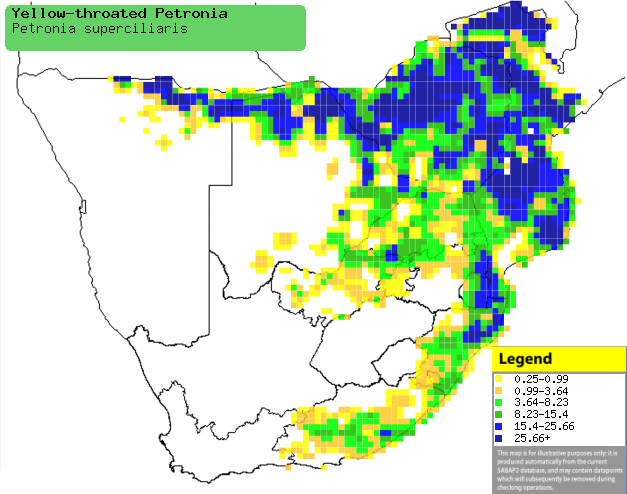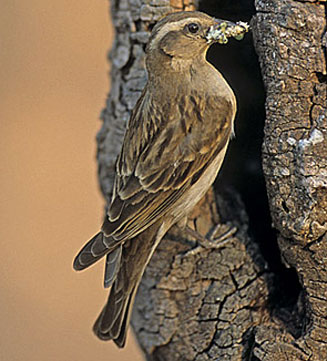|
Petronia superciliaris
(Yellow-throated petronia, Yellow-throated sparrow)
Geelvlekmossie [Afrikaans]; Enzunge (applied to some of
the bishops, widows and sparrows) [Kwangali]; Inzwa-unzwe [Shona]; Tswere
(generic term for sparrows, petronias and canaries [Tswana]; Kaapse rotsmus
[Dutch]; Moineau bridé [French]; Gelbkehlsperling [German];
Pardal-de-garganta-amarela [Portuguese]
Life
> Eukaryotes >
Opisthokonta
> Metazoa (animals) >
Bilateria >
Deuterostomia > Chordata >
Craniata > Vertebrata (vertebrates) > Gnathostomata (jawed
vertebrates) > Teleostomi (teleost fish) > Osteichthyes (bony fish) > Class:
Sarcopterygii (lobe-finned
fish) > Stegocephalia (terrestrial
vertebrates) > Tetrapoda
(four-legged vertebrates) > Reptiliomorpha > Amniota >
Reptilia (reptiles) >
Romeriida > Diapsida > Archosauromorpha > Archosauria >
Dinosauria
(dinosaurs) > Saurischia > Theropoda (bipedal predatory dinosaurs) >
Coelurosauria > Maniraptora > Aves
(birds) >
Order: Passeriformes > Family: Passeridae
Distribution and habitat
Occurs in sub-Equatorial Africa from southern DRC through
southern Tanzania, Zambia, Angola and Malawi to southern Africa. Here it is
fairly common in northern Namibia (including the Caprivi Strip), northern and
south-eastern Botswana, Zimbabwe, Mozambique and eastern South Africa, while
more scarce further west to the Eastern Cape and the North-West Province.
|
 |
|
Distribution of Yellow-throated petronia in southern Africa,
based on statistical smoothing of the records from first SA Bird Atlas
Project (©
Animal Demography unit, University of
Cape Town; smoothing by Birgit Erni and Francesca Little). Colours range
from dark blue (most common) through to yellow (least common).
See here for the latest distribution
from the SABAP2. |
Brood parasites
It has been recorded as host of the
Greater honeyguide and
Lesser honeyguide.
Food
It mainly eats arthropods, seeds and nectar, foraging both
on the ground and in the tree canopy, gleaning food from leaves and branches. The following food items have been recorded
in its diet:
- Plants
- seeds
- nectar
- Aloe
- A. marlothii (Mountain aloe)
- A. candelabrum (Candelabra aloe)
- A. greatheadii (Spotted aloe)
- mistletoes (Loranthaceae)
- Arthropods
Breeding
- Monogamous with a life-long pair bond, nesting solitarily and defending
its territory against intruders.
- The nest is probably built by the female, consisting of a cup attached
to a pad, made of old-man's-beard lichen (Usnea) and grass and lined
with hair and feathers. It is typically placed in a cavity in the trunk of a
tree, which can be natural or the old nest of a
barbet or
woodpecker.
 |
|
|
Yellow-throated petronia at its hollow, Mutinondo,
Zambia. [photo Warwick Tarboton ©] |
|
- Egg-laying season is from August-March, peaking from about
August-November.
- It lays 2-5 eggs, which are incubated solely by the female for about
11-19 days.
- The chicks are brooded by the female for the first 9-13 days of their
lives and are fed by both parents, leaving the nest after about 17-19 days
and becoming fully independent about 3 weeks later.
Threats
Not threatened.
References
-
Hockey PAR, Dean WRJ and Ryan PG 2005. Roberts
- Birds of southern Africa, VIIth ed. The Trustees of the John Voelcker
Bird Book Fund, Cape Town.
|
